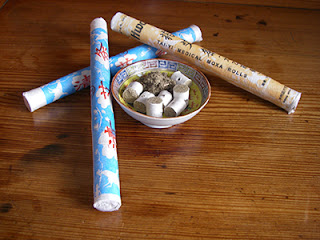First time patients are
often surprised when asked to stick out their tongue. And they are even more
puzzled when six pulses are taken on both wrists.
The tongue and pulse are
the diagnostic tools that help acupuncturists formulate a Traditional Chinese Medicine
treatment plan. The treatment plan includes the choice of acupuncture points,
the understanding of the specific meridians that need to be regulated, and
whether or not herbal medicine will be used. But before a treatment plan can be
established, acupuncturists must first consult the tongue and pulse.
I like to think of reading
the tongue and pulse as looking into a window into the internal workings of my
patients. Both are good indicators of what is going on internally with respect
to the health and balance of the body. This is a valuable way of checking in,
and a useful gauge for monitoring the improvements or decline of established
patients’ health from treatment to treatment, or to observe clinical
manifestations in the first time patient.
Reading the Tongue
The tongue is a map of
your body’s organs. There are five zones that correspond to each of the
internal organs.
When a person is not
healthy, the tongue reflect this change. A deep red tongue can indicate inflammation
or heat and, in contrast, a pale tongue can indicate anemia or blood vacuity.
And a purplish tongue points to poor circulation, or what is known as blood
stasis.
The observation of the
color of the tongue body has clinical importance as it most often reflects the
true condition of the patient. Reading a tongue can open up a dialogue with a
patient and help in gleaning deeper understanding of the disharmonies within
the body.
The shape and size of the
tongue can give further insight into the health of the patient. For example, a
swollen, puffy tongue with scalloped shaped sides can indicate that fluids are
not being properly metabolized, and digestion is not optimal. Whereas a small,
short, dry tongue can indicate a deficiency of fluids from dehydration or
inflammation.
The final indicator is the
tongue’s coating and thickness. These reflect the strength of the pathogenic
factors as well as the progression and location of disease. For example, a
thick yellow tongue coat can reflect a condition that is hot and more acute.
Conversely, a thick white coat indicates a cold and chronic condition. A tongue
completely without a coat can be indicative of a depletion of fluids, as well
as point to a more long-standing chronic condition.
With a simple glance at
your tongue, an acupuncturist can make an important and valuable diagnosis.
Reading the Pulse
Pulse diagnosis is another
tool that acupuncturists have to help determine the health of the patient.
However, reading the pulse is more subtle and subjective than reading the
tongue, and may be more complicated to explain.
There are three positions
on each wrist that represent a pair of organs. On the right wrist, position
one, closest to the thumb, is lung/large intestine, position two, the middle
position, is the spleen/stomach, and the third position represents the kidney
yin (the yin energy
source of the body).
On the left wrist, the
first position is the heart/small intestine, the second position is the
liver/gallbladder, and the third position is the kidney yang (the yang energy source of the
body).
The strengths and weakness
of the pulses are used diagnostically to assess the conditions of the organs
systems, as well as any underlying imbalances of the body. To make things even
more difficult, there are 27 pulse types – from descriptions such as floating
(indicative of a flu or cold invasion), wiry or choppy (indicating stress or
anxiety), and slippery (where a patient could be pregnant). All these pulse
types have clinical significance and influence the treatment plan and protocol.
So when asked to stick out
your tongue or show your wrist, you now know that your internal world is being
revealed.




